Play video — original link
Play video
Play video
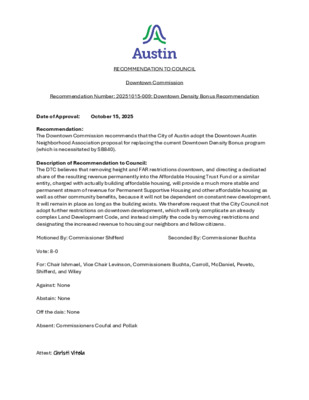
RECOMMENDATION TO COUNCIL Downtown Commission Recommendation Number: 20251015-009: Downtown Density Bonus Recommendation Date of Approval: October 15, 2025 Recommendation: The Downtown Commission recommends that the City of Austin adopt the Downtown Austin Neighborhood Association proposal for replacing the current Downtown Density Bonus program (which is necessitated by SB840). Description of Recommendation to Council: The DTC believes that removing height and FAR restrictions downtown, and directing a dedicated share of the resulting revenue permanently into the Affordable Housing Trust Fund or a similar entity, charged with actually building affordable housing, will provide a much more stable and permanent stream of revenue for Permanent Supportive Housing and other affordable housing as well as other community benefits, because it will not be dependent on constant new development. It will remain in place as long as the building exists. We therefore request that the City Council not adopt further restrictions on downtown development, which will only complicate an already complex Land Development Code, and instead simplify the code by removing restrictions and designating the increased revenue to housing our neighbors and fellow citizens. Motioned By: Commissioner Shifferd Seconded By: Commissioner Buchta Vote: 8-0 For: Chair Ishmael, Vice Chair Levinson, Commissioners Buchta, Carroll, McDaniel, Peveto, Shifferd, and Wiley Against: None Abstain: None Off the dais: None Absent: Commissioners Coufal and Pollak Attest: Christi Vitela
Play audio
Play video

Backup
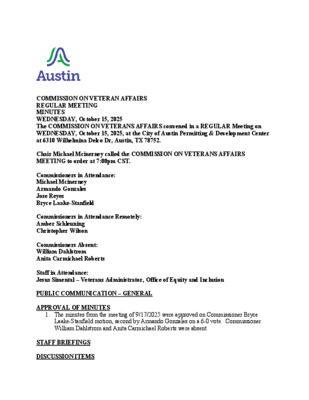
COMMISSION ON VETERAN AFFAIRS REGULAR MEETING MINUTES WEDNESDAY, October 15, 2025 The COMMISSION ON VETERANS AFFAIRS convened in a REGULAR Meeting on WEDNESDAY, October 15, 2025, at the City of Austin Permitting & Development Center at 6310 Wilhelmina Delco Dr, Austin, TX 78752. Chair Michael Mcinerney called the COMMISSION ON VETERANS AFFAIRS MEETING to order at 7:00pm CST. Commissioners in Attendance: Michael Mcinerney Armando Gonzales Jose Reyes Bryce Laake-Stanfield Commissioners in Attendance Remotely: Amber Schleuning Christopher Wilson Commissioners Absent: William Dahlstrom Anita Carmichael Roberts Staff in Attendance: Jesus Simental – Veterans Administrator, Office of Equity and Inclusion PUBLIC COMMUNICATION – GENERAL APPROVAL OF MINUTES 1. The minutes from the meeting of 9/17/2025 were approved on Commissioner Bryce Laake-Stanfield motion, second by Armando Gonzales on a 6-0 vote. Commissioner William Dahlstrom and Anita Carmichael Roberts were absent. STAFF BRIEFINGS DISCUSSION ITEMS 2. St. Edwards University: Dustin Noll presented on the challenges presented by the changing needs of younger veterans. Raised the point that it was well understood what veterans returning from the wars in Iraq & Afghanistan needed, and many were lined up to help — for example, mental healthcare for PTSD. Today, young Veterans are already becoming disconnected from this experience. needs are less clear and resources are more scarce. 3. Austin Community College: Dr. BethAnn Warwick presented on the challenges student veterans face pursuing higher education. Population of 1,600 Veterans at ACC, plus another 1,500 family members and spouses. ACC Military Network & Veteran Resource Center address main challenges of housing affordability, employment, and loss of community. DISCUSSION AND ACTION ITEMS 4. The Commission on Veterans Affairs 2026 annual meeting schedule was approved on Chair Michael Mcinerney motion and second by Christopher Wilson on a 6-0 vote. 5. A working group was established on motion by Chair Michael Mcinerney and second by Bryce-Laake Stanfied on a 6-0 vote to address veteran homelessness. The working group will be lead by Bryce Laake-Stanfield and consist of Chair Michael Mcinerney, Commissioner Christopher Wilson, Commissioner Armando Gonzales, and Vice Chair Amber Schleuning. FUTURE AGENDA ITEMS 6. Commissioner Bryce Laake-Stanfield to add to discussion and action items a creation of a veterans operations working group to focus on connecting the City of Austin with nonprofits that support veterans and also update the commission on the status of the veteran homeless working group. ADJOURNMENT END: 8:16 PM 7. Chair Michael Mcinerney made the motion to …
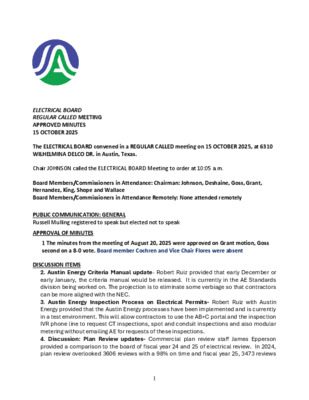
ELECTRICAL BOARD REGULAR CALLED MEETING APPROVED MINUTES 15 OCTOBER 2025 The ELECTRICAL BOARD convened in a REGULAR CALLED meeting on 15 OCTOBER 2025, at 6310 WILHELMINA DELCO DR. in Austin, Texas. Chair JOHNSON called the ELECTRICAL BOARD Meeting to order at 10:05 a.m. Board Members/Commissioners in Attendance: Chairman: Johnson, Deshaine, Goss, Grant, Hernandez, King, Shope and Wallace Board Members/Commissioners in Attendance Remotely: None attended remotely PUBLIC COMMUNICATION: GENERAL Russell Mulling registered to speak but elected not to speak APPROVAL OF MINUTES 1 The minutes from the meeting of August 20, 2025 were approved on Grant motion, Goss second on a 8-0 vote. Board member Cochren and Vice Chair Flores were absent DISCUSSION ITEMS 2. Austin Energy Criteria Manual update- Robert Ruiz provided that early December or early January, the criteria manual would be released. It is currently in the AE Standards division being worked on. The projection is to eliminate some verbiage so that contractors can be more aligned with the NEC. 3. Austin Energy Inspection Process on Electrical Permits- Robert Ruiz with Austin Energy provided that the Austin Energy processes have been implemented and is currently in a test environment. This will allow contractors to use the AB+C portal and the inspection IVR phone line to request CT inspections, spot and conduit inspections and also modular metering without emailing AE for requests of these inspections. 4. Discussion: Plan Review updates- Commercial plan review staff James Epperson provided a comparison to the board of fiscal year 24 and 25 of electrical review. In 2024, plan review overlooked 3606 reviews with a 98% on time and fiscal year 25, 3473 reviews 1 were performed with a 96% on time ratio. This was completed with 3 electrical reviewers with one vacancy. 5. Discussion on Building and Trade Contractors service (BTCS) update on staff and workload- Manager Maria Jaramillo provided that the building and trade contractor services lost 3 site and sub inspectors who were assisting with the BTCS with permitting processes. Currently in a hiring freeze, staff is offering overtime work for those wanting to work overtime. Currently in the process of hiring 3 temporary employees as interviewing of these positions are ongoing. Will be receiving assistance from an Austin Code staff in the coming days for additional help. 6. Update on Commercial and Residential Inspections- Residential supervisor Aaron Finney updated that residential inspection is sitting at 98.5 percent on time with …
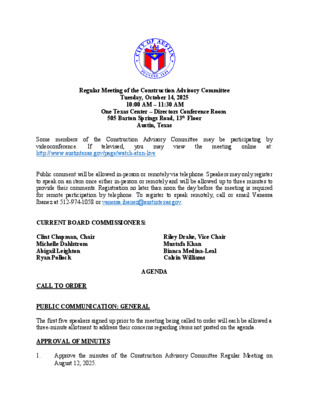
Regular Meeting of the Construction Advisory Committee Tuesday, October 14, 2025 10:00 AM – 11:30 AM One Texas Center – Directors Conference Room 505 Barton Springs Road, 13th Floor Austin, Texas Some members of videoconference. http://www.austintexas.gov/page/watch-atxn-live televised, If the Construction Advisory Committee may be participating by at: the meeting you may online view Public comment will be allowed in-person or remotely via telephone. Speakers may only register to speak on an item once either in-person or remotely and will be allowed up to three minutes to provide their comments. Registration no later than noon the day before the meeting is required for remote participation by telephone. To register to speak remotely, call or email Vanessa Ibanez at 512-974-1058 or vanessa.ibanez@austintexas.gov. CURRENT BOARD COMMISSIONERS: Clint Chapman, Chair Michelle Dahlstrom Abigail Leighton Ryan Pollock CALL TO ORDER Riley Drake, Vice Chair Mustafa Khan Bianca Medina-Leal Calvin Williams AGENDA PUBLIC COMMUNICATION: GENERAL The first five speakers signed up prior to the meeting being called to order will each be allowed a three-minute allotment to address their concerns regarding items not posted on the agenda. APPROVAL OF MINUTES 1. Approve the minutes of the Construction Advisory Committee Regular Meeting on August 12, 2025. STAFF BRIEFINGS 2. Staff briefing on Capital Delivery Services updates regarding active projects, monthly CIP spend, projects awarded and upcoming bid opportunities – Genest Landry DISCUSSION ITEMS 3. 4. Presentation from the Austin Small and Minority Business Resources on program updates – Edward Campos Presentation from Austin Development Services regarding the Expedited Permitting Process – Christopher Perez ADJOURNMENT The City of Austin is committed to compliance with the American with Disabilities Act. Reasonable modifications and equal access to communications will be provided upon request. Meeting locations are planned with wheelchair access. If requiring Sign Language Interpreters or alternative formats, please give notice at least 2 days (48 hours) before the meeting date. Please call Vanessa Ibanez with Capital Delivery Services Department, at 512-974-1058, for additional information; TTY users’ route through Relay Texas at 711. For more information on the Construction Advisory Committee, please contact Vanessa Ibanez at 512-974-1058
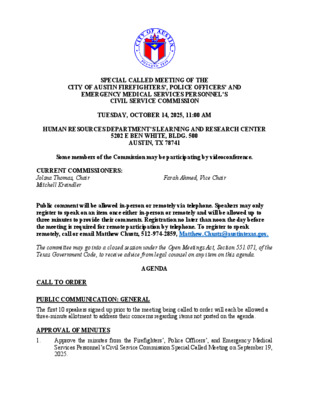
SPECIAL CALLED MEETING OF THE CITY OF AUSTIN FIREFIGHTERS’, POLICE OFFICERS’ AND EMERGENCY MEDICAL SERVICES PERSONNEL’S CIVIL SERVICE COMMISSION TUESDAY, OCTOBER 14, 2025, 11:00 AM HUMAN RESOURCES DEPARTMENT’S LEARNING AND RESEARCH CENTER 5202 E BEN WHITE, BLDG. 500 AUSTIN, TX 78741 Some members of the Commission may be participating by videoconference. CURRENT COMMISSIONERS: Jolsna Thomas, Chair Mitchell Kreindler Farah Ahmed, Vice Chair Public comment will be allowed in-person or remotely via telephone. Speakers may only register to speak on an item once either in-person or remotely and will be allowed up to three minutes to provide their comments. Registration no later than noon the day before the meeting is required for remote participation by telephone. To register to speak remotely, call or email Matthew Chustz, 512-974-2859, Matthew.Chustz@austintexas.gov. The committee may go into a closed session under the Open Meetings Act, Section 551.071, of the Texas Government Code, to receive advice from legal counsel on any item on this agenda. CALL TO ORDER AGENDA PUBLIC COMMUNICATION: GENERAL The first 10 speakers signed up prior to the meeting being called to order will each be allowed a three-minute allotment to address their concerns regarding items not posted on the agenda. APPROVAL OF MINUTES 1. Approve the minutes from the Firefighters’, Police Officers’, and Emergency Medical Services Personnel’s Civil Service Commission Special Called Meeting on September 19, 2025. DISCUSSION AND ACTION ITEMS 2. Hear and rule on appeal(s) from the Austin Fire Department Captain written promotional examination administered on September 29, 2025, pursuant to the Texas Local Government Code, Section 143.034, and the City of Austin Fire Fighters’, Police Officers’ and Emergency Medical Services Personnel’s Civil Service Commission Rules and Regulations, Rule 7. 3. Discussion and action to approve future meeting dates and times. STAFF BRIEFINGS 4. Staff briefing from the Civil Service Office regarding promotional examination processes, disciplinary hearings, and fitness-for-duty actions. FUTURE AGENDA ITEMS ADJOURNMENT The City of Austin is committed to compliance with the American with Disabilities Act. Reasonable modifications and equal access to communications will be provided upon request. Meeting locations are planned with wheelchair access. If requiring Sign Language Interpreters or alternative formats, please give notice at least 2 days (48 hours) before the meeting date. Please call Matthew Chustz at the Human Resources Department, at 512-974-2859, for additional information; TTY users’ route through Relay Texas at 711. For more information on the City of Austin Firefighters’, Police …
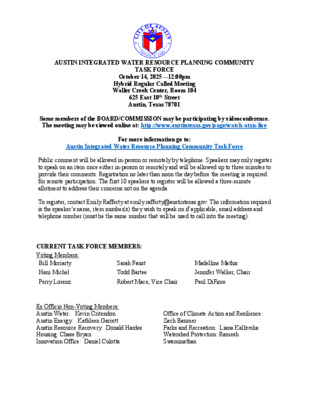
AUSTIN INTEGRATED WATER RESOURCE PLANNING COMMUNITY TASK FORCE October 14, 2025 --12:00pm Hybrid Regular Called Meeting Waller Creek Center, Room 104 625 East 10th Street Austin, Texas 78701 Some members of the BOARD/COMMISSION may be participating by videoconference. The meeting may be viewed online at: http://www.austintexas.gov/page/watch-atxn-live For more information go to: Austin Integrated Water Resource Planning Community Task Force Public comment will be allowed in-person or remotely by telephone. Speakers may only register to speak on an item once either in-person or remotely and will be allowed up to three minutes to provide their comments. Registration no later than noon the day before the meeting is required for remote participation. The first 10 speakers to register will be allowed a three-minute allotment to address their concerns not on the agenda. To register, contact Emily Rafferty at emily.rafferty@austintexas.gov. The information required is the speaker’s name, item number(s) they wish to speak on if applicable, email address and telephone number (must be the same number that will be used to call into the meeting). CURRENT TASK FORCE MEMBERS: Voting Members: Bill Moriarty Sarah Faust Hani Michel Perry Lorenz Todd Bartee Robert Mace, Vice Chair Paul DiFiore Madelline Mathis Jennifer Walker, Chair Ex Officio Non-Voting Members: Austin Water: Kevin Critendon Austin Energy: Kathleen Garrett Austin Resource Recovery: Donald Hardee Housing: Chase Bryan Innovation Office: Daniel Culotta Office of Climate Action and Resilience: Zach Baumer Parks and Recreation: Liana Kallivoka Watershed Protection: Ramesh Swaminathan AGENDA CALL TO ORDER – PUBLIC COMMUNICATION: GENERAL APPROVAL OF MINUTES 1. Approve the meeting minutes from the Regular Called Task Force meeting on June 10, 2025. DISCUSSION ITEMS 2. Update on Lower Colorado River and Highland Lakes water supply conditions 3. Update on Austin Water’s water distribution system water loss and mitigation 4. Presentation of Q2 Water Management Strategy Implementation Report ACTION ITEMS 5. Review and approve the 2026 Water Forward Task Force meeting schedule FUTURE AGENDA ITEMS ADJOURN The City of Austin is committed to compliance with the American with Disabilities Act. Reasonable modifications and equal access to communications will be provided upon request. Meeting locations are planned with wheelchair access. If requiring Sign Language Interpreters or alternative formats, please give notice at least 2 days (48 hours) before the meeting date. Please call Austin Integrated Water Resource Planning Community Task Force Liaison, Emily Rafferty at 512-972-0427, for additional information; TTY users route through Relay Texas at 711. …

REGULAR MEETING of the PLANNING COMMISSION TUESDAY, OCTOBER 14, 2025, 6:00 PM AUSTIN CITY HALL, COUNCIL CHAMBERS, ROOM 1001 301 WEST 2ND STREET AUSTIN, TEXAS Some members of the Planning Commission may be participating by videoconference. The meeting may be viewed online at: http://www.austintexas.gov/page/watch-atxn-live. Public comment will be allowed in-person or remotely via telephone. Speakers may only register to speak on an item once either in-person or remotely. Registration no later than 2 PM the day of the meeting is required for remote participation by telephone. For more information on public comment, please see the agenda section “Speaker Registration.” Please contact Ella Garcia, Staff Liaison, for questions regarding speaker registration at LandUseLiaison@austintexas.gov or by phone at 512-978-0821. CURRENT COMMISSIONERS: Alice Woods, Chair (District 2) Casey Haney, Vice Chair (Mayor’s Representative) Felicity Maxwell, Secretary (District 5) Imad Ahmed, Parliamentarian (District 6) Anna Lan (Mayor’s Representative) Vacant (Mayor’s Representative) Patrick Howard (District 1) EX-OFFICIO MEMBERS: Nadia Barrera-Ramirez (District 3) Brian Bedrosian (District 4) Adam Powell (District 7) Peter Breton (District 8) Danielle Skidmore (District 9) Joshua Hiller (District 10) Jessica Cohen, Chair of Board of Adjustment TC Broadnax, City Manager Candace Hunter, A.I.S.D. Board of Trustees Richard Mendoza, Director of Transportation and Public Works EXECUTIVE SESSION (No public discussion) The Planning Commission will announce it will go into Executive Session, if necessary, according to Chapter 551 of the Texas Government Code, to receive advice from Legal Counsel on matters specifically listed on the agenda. The Commission may not conduct a closed meeting without the approval of the city attorney. Private Consultation with Attorney – Section 551.071. Staff Liaison: Ella Garcia, 512-978-0821 Attorney: Steve Maddoux, 512-974-6080 Page 1 of 7 AGENDA CALL TO ORDER PUBLIC COMMUNICATION: GENERAL The first four speakers signed up prior to the meeting being called to order will each be allowed a three-minute allotment to address their concerns regarding items not posted on the agenda. APPROVAL OF MINUTES 1. Approve the minutes of the Planning Commission regular meeting on Tuesday, September 23, 2025. PUBLIC HEARINGS 2. Plan Amendment: NPA-2024-0018.01 - 7003, 7005, 7007 Guadalupe Street Rezone; Location: District 4 7003, 7005, 7007 Guadalupe Street, Waller Creek Watershed; Brentwood/Highland Combined (Highland) Neighborhood Planning Area Owner/Applicant: Purple Square One Limited Liability (Lan Chen) Agent: Request: Bowman (Jerome Perales, P.E.) High Density Single Family and Multifamily Residential to Mixed Use land use Applicant postponement request to December 9, 2025 Maureen Meredith, 512-974-2695, …

From: To: Cc: Subject: Date: Attachments: Julia Perales-Leisk Boudreaux, Marcelle Meredith, Maureen RE: Request for Postponement - NPA-2024-0018.01 & C14-2024-0036_7003 Guadalupe Wednesday, September 24, 2025 1:06:10 PM image001.png image002.png image003.png image004.png External Email - Exercise Caution Hello Marcelle, I think it would best to do Dec 9th since we still do not know if a ZTA will be required with the new unit counts. JULIA PERALES-LEISK Planning & Development Manager | BOWMAN julia.leisk@bowman.com | bowman.com From: Boudreaux, Marcelle <Marcelle.Boudreaux@austintexas.gov> Sent: Wednesday, September 24, 2025 9:30 AM To: Julia Perales-Leisk <julia.leisk@bowman.com> Cc: Meredith, Maureen <Maureen.Meredith@austintexas.gov> Subject: [EXTERNAL] RE: Request for Postponement - NPA-2024-0018.01 & C14-2024-0036_7003 Guadalupe Hi Julia, Please confirm the PC date to which you are requesting Postponement. Thanks! Marcelle Boudreaux, MCRP, AICP, Assoc. AIA Planner Senior Planning Department 512-974-8094 marcelle.boudreaux@austintexas.gov 02 NPA-2024-0018.01 - 7003, 7005, 7007 Guadalupe Street Rezone; District 41 of 2 Please note: Email correspondence to and from the City of Austin is subject to required disclosure under the Texas Public Information Act. -----Original Message----- From: Julia Perales-Leisk <julia.leisk@bowman.com> Sent: Tuesday, September 23, 2025 4:11 PM To: Boudreaux, Marcelle <Marcelle.Boudreaux@austintexas.gov> Cc: Meredith, Maureen <Maureen.Meredith@austintexas.gov> Subject: Re: Request for Postponement - NPA-2024-0018.01 & C14-2024-0036_7003 Guadalupe External Email - Exercise Caution Hello Marcelle, Please postpone the zoning and NPA applications since we waiting to get the approved TIA Determination worksheet to determine if we will be amending our applications. Thank you. JULIA PERALES-LEISK Planning & Development Manager | BOWMAN O: (512) 327-2308 julia.leisk@bowman.com<mailto:julia.leisk@bowman.com> ________________________________ From: Julia Perales-Leisk <julia.leisk@bowman.com> Sent: Tuesday, September 23, 2025 9:30:55 AM To: Boudreaux, Marcelle <Marcelle.Boudreaux@austintexas.gov> Cc: Meredith, Maureen <Maureen.Meredith@austintexas.gov> Subject: RE: Request for Postponement - NPA-2024-0018.01 & C14-2024-0036_7003 Guadalupe Goo morning Marcelle. 02 NPA-2024-0018.01 - 7003, 7005, 7007 Guadalupe Street Rezone; District 42 of 2

From: To: Cc: Subject: Date: Attachments: Julia Perales-Leisk Boudreaux, Marcelle Meredith, Maureen RE: Request for Postponement - NPA-2024-0018.01 & C14-2024-0036_7003 Guadalupe Wednesday, September 24, 2025 1:06:10 PM image001.png image002.png image003.png image004.png External Email - Exercise Caution Hello Marcelle, I think it would best to do Dec 9th since we still do not know if a ZTA will be required with the new unit counts. JULIA PERALES-LEISK Planning & Development Manager | BOWMAN julia.leisk@bowman.com | bowman.com From: Boudreaux, Marcelle <Marcelle.Boudreaux@austintexas.gov> Sent: Wednesday, September 24, 2025 9:30 AM To: Julia Perales-Leisk <julia.leisk@bowman.com> Cc: Meredith, Maureen <Maureen.Meredith@austintexas.gov> Subject: [EXTERNAL] RE: Request for Postponement - NPA-2024-0018.01 & C14-2024-0036_7003 Guadalupe Hi Julia, Please confirm the PC date to which you are requesting Postponement. Thanks! Marcelle Boudreaux, MCRP, AICP, Assoc. AIA Planner Senior Planning Department 512-974-8094 marcelle.boudreaux@austintexas.gov 03 C14-2024-0036 - 7003, 7005, 7007 Guadalupe Street Rezone; District 41 of 2 Please note: Email correspondence to and from the City of Austin is subject to required disclosure under the Texas Public Information Act. -----Original Message----- From: Julia Perales-Leisk <julia.leisk@bowman.com> Sent: Tuesday, September 23, 2025 4:11 PM To: Boudreaux, Marcelle <Marcelle.Boudreaux@austintexas.gov> Cc: Meredith, Maureen <Maureen.Meredith@austintexas.gov> Subject: Re: Request for Postponement - NPA-2024-0018.01 & C14-2024-0036_7003 Guadalupe External Email - Exercise Caution Hello Marcelle, Please postpone the zoning and NPA applications since we waiting to get the approved TIA Determination worksheet to determine if we will be amending our applications. Thank you. JULIA PERALES-LEISK Planning & Development Manager | BOWMAN O: (512) 327-2308 julia.leisk@bowman.com<mailto:julia.leisk@bowman.com> ________________________________ From: Julia Perales-Leisk <julia.leisk@bowman.com> Sent: Tuesday, September 23, 2025 9:30:55 AM To: Boudreaux, Marcelle <Marcelle.Boudreaux@austintexas.gov> Cc: Meredith, Maureen <Maureen.Meredith@austintexas.gov> Subject: RE: Request for Postponement - NPA-2024-0018.01 & C14-2024-0036_7003 Guadalupe Goo morning Marcelle. 03 C14-2024-0036 - 7003, 7005, 7007 Guadalupe Street Rezone; District 42 of 2
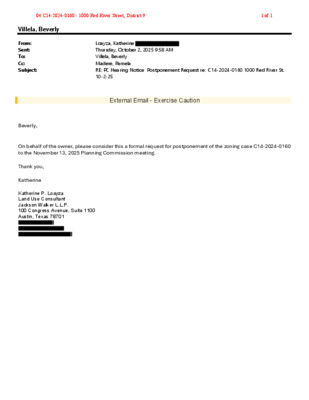
Villela, Beverly From: Sent: To: Cc: Subject: Beverly, Loayza, Katherine Thursday, October 2, 2025 9:58 AM Villela, Beverly Madere, Pamela RE: PC Hearing Notice Postponement Request re: C14-2024-0160 1000 Red River St. 10-2-25 External Email - Exercise Caution On behalf of the owner, please consider this a formal request for postponement of the zoning case C14-2024-0160 to the November 13, 2025 Planning Commission meeting. Thank you, Katherine Katherine P. Loayza Land Use Consultant Jackson Walker L.L.P. 100 Congress Avenue, Suite 1100 Austin, Texas 78701 04 C14-2024-0160 - 1000 Red River Street; District 91 of 1

ZONING CHANGE REVIEW SHEET CASE: C14-2024-0160 (1000 Red River) DISTRICT: 9 ADDRESS: 1001 Trinity Street, 416 ½ East 10th Street, 502 ½ East 10th Street, 1000 Red River, 1001 ½ Red River Street, 1018 Red River Street, 1020 Red River Street, 503 East 11th Street, 505 East 11th Street, 509 ½ East 11th Street, 516 ½ East 11th Street ZONING FROM: DMU, CS, CS-1, MF-4 TO: DMU SITE AREA: 4.01 acres (174,675.6sq. ft.) PROPERTY OWNER: Austin Real Estate Acquisitions LLC AGENT: Jackson Walker LLP (Pamela Madere) CASE MANAGER: Beverly Villela (512-978-0740, Beverly.Villela@austintexas.gov) STAFF RECOMMENDATION: Staff recommendation is to grant Downtown Mixed Use (DMU) district zoning. See the Basis of Recommendation section below. PLANNING COMMISSION ACTION / RECOMMENDATION: October 14, 2025: CITY COUNCIL ACTION: TBD ORDINANCE NUMBER: ISSUES: N/A CASE MANAGER COMMENTS: The property in question consists of approximately 4.01 acres at 1001 Trinity Street, 416 ½ East 10th Street, 502 ½ East 10th Street, 1000 Red River, 1001 ½ Red River Street, 1018 Red River Street, 1020 Red River Street, 503 East 11th Street, 505 East 11th Street, 509 ½ East 11th Street and 516 ½ East 11th Street located within the Core/Waterfront District of the Downtown Austin Plan (DAP). It is currently zoned DMU, CS, CS-1, and MF-4 and the applicant is requesting DMU zoning across the entire tract to establish a single cohesive district for future redevelopment. The site is currently developed with two large office buildings constructed by the State of Texas to house the Teacher Retirement Systems facilities, which remain the current 04 C14-2024-0160 - 1000 Red River Street; District 91 of 13 C14-2024-0160 Page 2 occupant. The property occupies a full city block bounded by Red River Street, East 10th Street, Trinity Street, and East 11th Street, within a highly connected portion of downtown Austin. The Downtown Austin Plan recommends DMU zoning for this location. The Core/Waterfront District is envisioned as the region’s premier employment, cultural, and visitor center, supported by policies such as: • AU-5 (maintaining Downtown’s employment role), • AU-1.2 (prioritizing key uses), and • DD-1.1 (aligning density with surrounding context). A uniform DMU designation will support redevelopment at densities and with uses consistent with downtown’s transitional edges between the CBD core and adjacent districts. The rezoning request aligns strongly with the Imagine Austin Decision Guidelines, meeting 10 measures. The site lies within the Downtown Regional Center, is within 0.05 miles of multiple …

Affordability Impact Statement Central Business District Height Amendment Case number: C20-2025-010 Date: 9/29/2025 Proposed Regulation The proposed ordinance and code amendments will add a maximum base height of 350 feet to the 25-2-492 Central Business District (CBD) site development regulations and update 25-2-586 Downtown Density Bonus Program and 25-2-739 Rainey Street Subdistrict Regulations accordingly to modify allowable maximum height when participating in the DDBP. Background CBD zoning does not currently have a height limit, instead regulating building size through a maximum floor- to-area ratio (FAR) of 8:1. Downtown development that proposes to exceed the allowed FAR or the maximum height allowed under the site's primary entitlements could participate in the Downtown Density Bonus (DDB) program to receive additional entitlements in exchange for specified community benefits. However, Senate Bill 840 (SB 840) from the State of Texas’ 89th regular legislative session, effective since September 1, 2025, removed the City of Austin’s ability to regulate development in CBD zoning through FAR. This means that there is currently no FAR for CBD zones, introducing the need for a height amendment. Austin Planning analyzed developments permitted under CBD zoning from 2006 to 2025 to understand trends and determine an appropriate base height entitlement. Their analysis observed 14 non-DDB cases and 43 DDB cases. Table 1 and Table 2 show summary statistics from those developments. Table 1: Summary Statistics for Density Bonus Sites in CBD Zoning Density Bonus Sites CBD Median CBD Average Site Area (acres) 0.55 0.72 Floors Height 39 39 447 466 Floors with 8:1 FAR* 16 18 Height with 8:1 FAR* 207 223 * Base floor and height with 8:1 FAR equivalent for developed sites. Source: Austin Planning 06 C20-2025-010 - CBD Amendments1 of 7 Table 2: Summary Statistics for Non-Density Bonus Sites in CBD Zoning Site Area (acres) Floors Height Non-Density Bonus Sites * Base floor and height with 8:1 FAR equivalent for developed sites. CBD Median CBD Average 0.71 0.95 31 30 367 382 Floors with 8:1 FAR* 19 22 Height with 8:1 FAR* 235 278 Source: Austin Planning Austin Planning’s analysis also shows that median development heights in CBD zoning have been increasing significantly since 2010, while median lot sizes have trended somewhat smaller (Figures 1 and 2). Refer to the staff report from Austin Planning for background and analysis of for this proposed regulation. Figure 1 Source: City of Austin permit data 06 C20-2025-010 - CBD Amendments2 of …

C20-2025-010 Central Business District Amendments Alan Pani, Principal Planner | Austin Planning | 10/14/25 Planning Commission Content • Background • Proposed Changes • Next Steps Background Texas Senate Bill 840 Texas SB 840 went into effect on September 1. Allows for multifamily or mixed-use in any commercial zone Under SB 840, multifamily and mixed-use residential developments in commercial zones will, by right, be able to: Reach a height that is the greater of 45 feet or the height that applies to commercial uses for the site. Reach a density of up to 54 units per acre. Include setbacks that are the lesser of 25 feet or the setbacks imposed on commercial uses. Develop unlimited floor-to-area ratio (FAR). 4 Central Business District Central Business District (CBD) is the designation for an office, commercial, residential, or civic use located in the downtown area CBD currently regulates development based on floor-area ratio (FAR) Currently, the allowed FAR is 8:1 There is no maximum building height under CBD As of September 1, the City can no longer regulate FAR in developments utilizing Senate Bill 840 CBD 5 Downtown Density Bonus Produces highest density/heights in our city and produces the most affordable housing fees- in-lieu for the City CBD and Downtown Mixed Use (DMU) zoning today: CBD zoning does not have a height limit but has FAR limit of 8:1. DMU zoning has height limit of 120’ and FAR limit of 5:1. DDB allows for developments to go above their base entitlements Additional entitlements are mapped, but in general, DDB can increase CBD and DMU sites: Up to 25:1 FAR Up to unlimited height 6 Proposed Changes CBD Median Height Equivalent Staff analyzed the median and average height for sites participating in the Downtown Density Bonus to find the height equivalent for 8:1 FAR Site Area (acres) Floors with 8:1 FAR* Height with 8:1 FAR* (feet) Density Bonus Sites CBD Median CBD Average 0.55 0.72 *8:1 FAR equivalent for developed sites. 16 18 207 233 8 9 10 Proposed Changes to CBD Create a new maximum by-right height limit of 350 feet for the Central Business District. 350 feet follows the trend toward taller buildings in Downtown to help support development and growth in the city center. The height limit will …
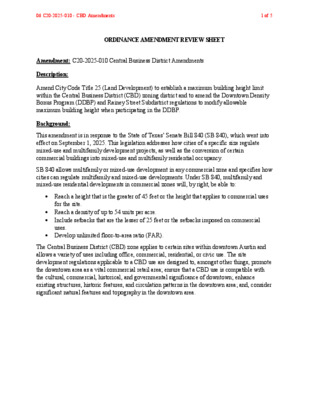
ORDINANCE AMENDMENT REVIEW SHEET Amendment: C20-2025-010 Central Business District Amendments Description: Amend City Code Title 25 (Land Development) to establish a maximum building height limit within the Central Business District (CBD) zoning district and to amend the Downtown Density Bonus Program (DDBP) and Rainey Street Subdistrict regulations to modify allowable maximum building height when participating in the DDBP. Background: This amendment is in response to the State of Texas’ Senate Bill 840 (SB 840), which went into effect on September 1, 2025. This legislation addresses how cities of a specific size regulate mixed-use and multifamily development projects, as well as the conversion of certain commercial buildings into mixed-use and multifamily residential occupancy. SB 840 allows multifamily or mixed-use development in any commercial zone and specifies how cities can regulate multifamily and mixed-use developments. Under SB 840, multifamily and mixed-use residential developments in commercial zones will, by right, be able to: • Reach a height that is the greater of 45 feet or the height that applies to commercial uses for the site. • Reach a density of up to 54 units per acre. • Include setbacks that are the lesser of 25 feet or the setbacks imposed on commercial uses. • Develop unlimited floor-to-area ratio (FAR). The Central Business District (CBD) zone applies to certain sites within downtown Austin and allows a variety of uses including office, commercial, residential, or civic use. The site development regulations applicable to a CBD use are designed to, amongst other things, promote the downtown area as a vital commercial retail area; ensure that a CBD use is compatible with the cultural, commercial, historical, and governmental significance of downtown; enhance existing structures, historic features, and circulation patterns in the downtown area; and, consider significant natural features and topography in the downtown area. 06 C20-2025-010 - CBD Amendments1 of 5 CBD CBD zoning regulates development via floor-to-area ratio (FAR) and does not state a maximum building height. The allowed FAR for CBD is eight to one. Downtown development that proposes to exceed the allowed FAR or the maximum height allowed under the site's primary entitlements may participate in the Downtown Density Bonus (DDB) program to receive additional entitlements in exchange for specified community benefits. Austin Planning has analyzed developments that have been built under CBD zoning to estimate what heights the current 8:1 FAR has resulted in. Density Bonus Sites * Base floor and height with …
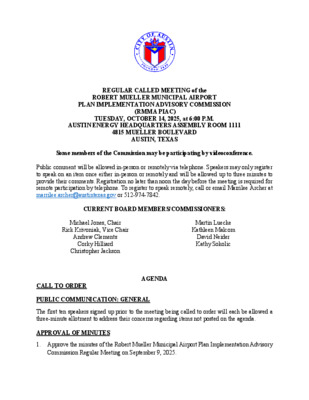
REGULAR CALLED MEETING of the ROBERT MUELLER MUNICIPAL AIRPORT PLAN IMPLEMENTATION ADVISORY COMMISSION (RMMA PIAC) TUESDAY, OCTOBER 14, 2025, at 6:00 P.M. AUSTIN ENERGY HEADQUARTERS ASSEMBLY ROOM 1111 4815 MUELLER BOULEVARD AUSTIN, TEXAS Some members of the Commission may be participating by videoconference. Public comment will be allowed in-person or remotely via telephone. Speakers may only register to speak on an item once either in-person or remotely and will be allowed up to three minutes to provide their comments. Registration no later than noon the day before the meeting is required for remote participation by telephone. To register to speak remotely, call or email Marrilee Archer at marrilee.archer@austintexas.gov or 512-974-7842. CURRENT BOARD MEMBERS/COMMISSIONERS: Michael Jones, Chair Rick Krivoniak, Vice Chair Andrew Clements Corky Hilliard Christopher Jackson Martin Luecke Kathleen Malcom David Neider Kathy Sokolic CALL TO ORDER AGENDA PUBLIC COMMUNICATION: GENERAL The first ten speakers signed up prior to the meeting being called to order will each be allowed a three-minute allotment to address their concerns regarding items not posted on the agenda. APPROVAL OF MINUTES 1. Approve the minutes of the Robert Mueller Municipal Airport Plan Implementation Advisory Commission Regular Meeting on September 9, 2025. DISCUSSION ITEMS 2. Annual Report and Discussion by Banbury regarding Minority-Owned or Women-Owned Business Enterprise Briefing 3. Discussion by Banbury regarding Mueller Development updates DISCUSSION AND ACTION ITEMS 4. Discuss and approve the 2026 RMMA PIAC Meeting Schedule 5. Discussion by Commissioners on a potential recommendation to City Council on Retirement Living at Mueller with Healthcare Options FUTURE AGENDA ITEMS ADJOURNMENT The City of Austin is committed to compliance with the American with Disabilities Act. Reasonable modifications and equal access to communications will be provided upon request. Meeting locations are planned with wheelchair access. If requiring Sign Language Interpreters or alternative formats, please give notice at least 2 days (48 hours) before the meeting date. Please call Marrilee Archer with Austin Financial Services (AFS), at 512-974-7842, for additional information; TTY users route through Relay Texas at 711. For more information on the Robert Mueller Municipal Airport Plan Implementation Advisory Commission, please contact Marrilee Archer with Austin Financial Services at 512-974-7842.
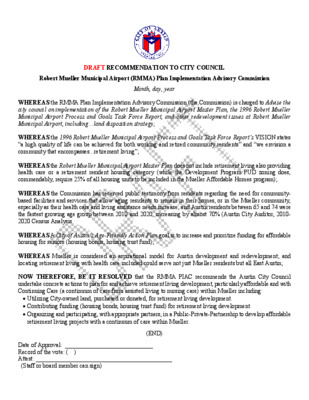
DRAFT RECOMMENDATION TO CITY COUNCIL Robert Mueller Municipal Airport (RMMA) Plan Implementation Advisory Commission Month, day, year WHEREAS the RMMA Plan Implementation Advisory Commission (the Commission) is charged to Advise the city council on implementation of the Robert Mueller Municipal Airport Master Plan, the 1996 Robert Mueller Municipal Airport Process and Goals Task Force Report, and other redevelopment issues at Robert Mueller Municipal Airport, including…land disposition strategy; WHEREAS the 1996 Robert Mueller Municipal Airport Process and Goals Task Force Report’s VISION states “a high quality of life can be achieved for both working and retired community residents” and “we envision a community that encompasses...retirement living”; WHEREAS the Robert Mueller Municipal Airport Master Plan does not include retirement living also providing health care or a retirement resident housing category (while the Development Program PUD zoning does, commendably, require 25% of all housing units to be included in the Mueller Affordable Homes program); WHEREAS the Commission has received public testimony from residents regarding the need for community- based facilities and services that allow aging residents to remain in their homes, or in the Mueller community, especially as their health care and living assistance needs increase; and Austin residents between 65 and 74 were the fastest growing age group between 2010 and 2020, increasing by almost 70% (Austin City Auditor, 2010- 2020 Census Analysis WHEREAS A City of Austin’s Age-Friendly Action Plan goal is to increase and prioritize funding for affordable housing for seniors (housing bonds, housing trust fund); WHEREAS Mueller is considered an aspirational model for Austin development and redevelopment; and locating retirement living with health care included could serve not just Mueller residents but all East Austin; NOW THEREFORE, BE IT RESOLVED that the RMMA PIAC recommends the Austin City Council undertake concrete actions to plan for and achieve retirement living development, particularly affordable and with Continuing Care (a continuum of care from assisted living to nursing care) within Mueller including: • Utilizing City-owned land, purchased or donated, for retirement living development. • Contributing funding (housing bonds, housing trust fund) for retirement living development. • Organizing and participating, with appropriate partners, in a Public-Private-Partnership to develop affordable retirement living projects with a continuum of care within Mueller. (END) Date of Approval: _____________________________ Record of the vote: ( ) Attest: _____________________________________________ (Staff or board member can sign)